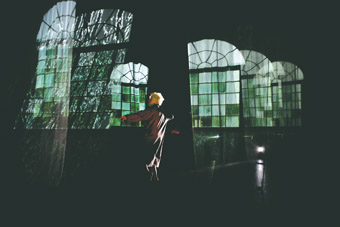the dance of inner space
keith gallasch: de quincey co, ghost quarters

Tess de Quincey, Ghost Quarters
photo Mayu Kanamori
Tess de Quincey, Ghost Quarters
WATCHING DE QUINCEY CO’S GHOST QUARTERS IS LIKE WITNESSING THE GROWTH OF A FOREIGN ORGANISM, ONE THAT TRIGGERS IN EQUAL PARTS CURIOSITY AND ANXIETY. NOT SURPRISINGLY IT’S AN APTLY GOTHIC EXPERIENCE. THOMAS DE QUINCEY (1785-1859), THE ESSAYIST WHOSE WRITINGS INSPIRED THIS WORK, NUMBERED AMONG HIS ENGLISH ELDERS AND PEERS THE PIONEERS OF THE LITERARY GOTHIC. ADDING ANOTHER LAYER OF EERINESS IS THE POSSIBILITY THAT TESS DE QUINCEY, HERE EMBODYING, OR SHOULD I SUGGEST CHANNELLING (IF IN NO WAY ENACTING) THE GREAT MAN, IS POSSIBLY ONE OF HIS DESCENDANTS.
Ghost Quarters evolves like an expanding, multiplying cell. The audience, embraced by surround sound, sits on either side of a large installation, its long strips of translucent material rising high into the ceiling. Projected onto and through them are immersive images created by Sam James that evoke the now dream-like environments—unkempt nature, a haunting household with ornate chairs and chandeliers, a huge industrial space (using CarriageWorks itself)— the writer once travelled through and by which he was psychologically shaped.
De Quincey is curled on the floor, quivering into life, or is it possession? As she rises to engage with this strange space, in movements that seem to alternate tremulously between claustro- and agoraphobia, so do images, visual and aural, begin to consume us. Shimmering grass reappears, grown spookily tall, an arched window appears on high, beckoning but threatening as the relentless chatter of the sound score suggests murder.
Later De Quincey grapples with the hung material, pulling it after her as if to take control of the writer’s disturbed vision (he wrote The Confessions of an Opium Addict), then ventures out towards the audience, almost as if seeing us, pushing at some inner boundary. Finally, she exits through a huge creaking CarriageWorks door to the outside world, as if perhaps released.
If Ghost Quarters is an intriguing work replete with moments of palpable tension and sublime beauty, it is also a work not fully grown. De Quincey is, as ever, fascinating to watch, but my engagement with Ghost Quarters was disturbed by the chattering sound score, a word salad reminiscent of experimental radio works of recent decades. The credits attribute the vocals to Amanda Stewart, but there’s an altogether odd mix of voices, accents and vocal styles, while the setting for Stewart’s own delivery is pitched so low as to make her often unintelligible.
Jane Goodall’s text, drawn from Thomas de Quincey’s writings, is interesting in itself, when you can pick it out from the echoing repetitions and layerings (presumably intended to suggest that he ‘heard voices’), but there doesn’t seem to be a lot to it. Each of its several key passages relate to moments in the essayist’s life, to events, psychological states and to ideas about nature and murder, but they are slender, leaving you greedy for more. No amount of sound manipulation and design can compensate. Why not something more from Thomas, just to make a little more sense of the man and his condition? This need not be a surrender to the conventions of documentary or narrative. And as there’s one Tess embodying Thomas, why not then one voice, Stewart’s? Ghost Quarters is a fascinating work that has room to grow, to become an organism both more spacious and dense.
–
De Quincey Co, Ghost Quarters, first dream of The Opium Confessions, dance Tess de Quincey, script Jane Goodall, vocals Amanda Stewart, video Sam James, sound Ian Stevenson, lighting Travis Hodgson, CarriageWorks, May 6-10
RealTime issue #91 June-July 2009 pg. 38






